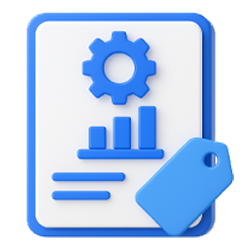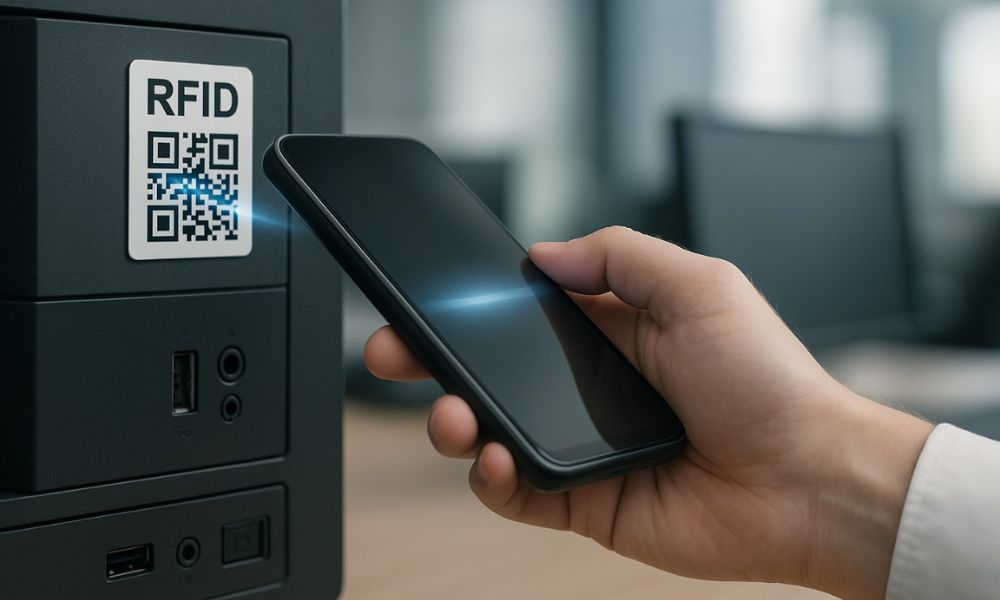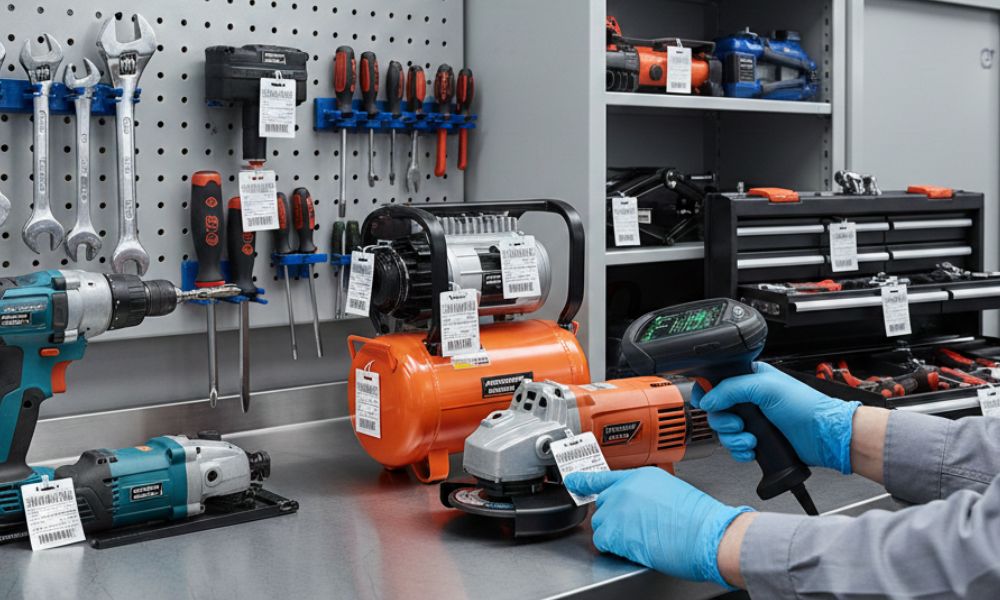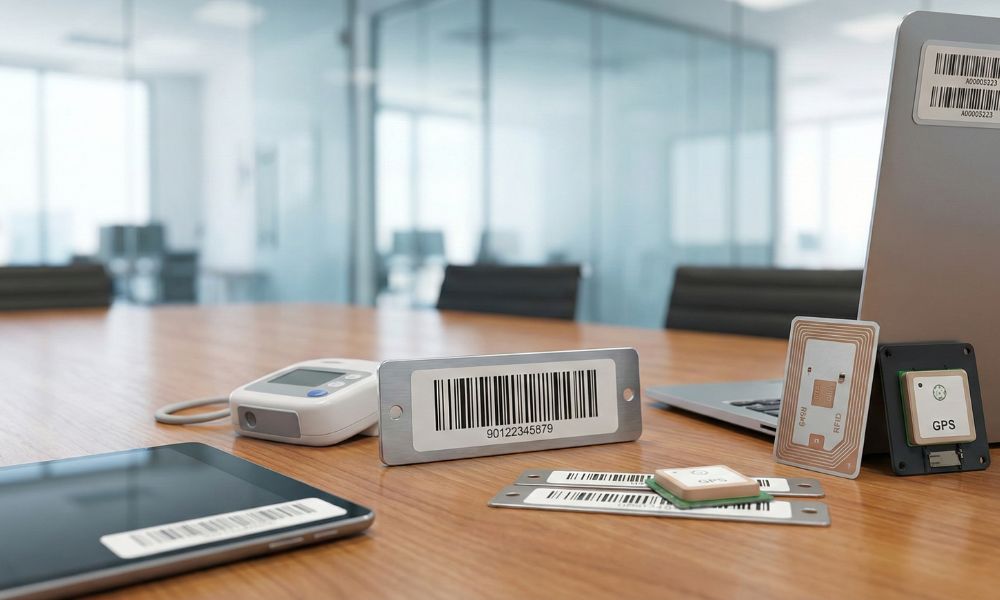Introduction
Asset managers globally face lost tools, slow audits, and costly reactive maintenance challenges. However, IoT for asset tracking combined with AI offers effective, modern solutions. IoT sensors and AI algorithms provide real-time tracking and predictive maintenance capabilities. From Bluetooth asset tracking to AI-driven sensors, these tools deliver continuous visibility and proactive insights.
Discover how to streamline physical asset management with our in-depth guide on –Asset Tagging and Management: Best Practices & Implementation Guide
This article explores IoT for asset tracking and AI-driven tagging systems. A case study shows AssetCues reduced downtime by 30% using IoT tags and AI analytics. We also cover trends like Bluetooth asset tracking, NFC asset tracking, and digital twins revolutionizing asset management.

How Does IoT Improve Equipment Tagging and Asset Tracking?
IoT enhances asset tagging by embedding assets with connected sensors like GPS, RFID, NFC, or Bluetooth beacons. These sensors automate real-time tracking of location, status, and movement. Unlike passive tags needing manual scans, IoT tags send continuous data to a central system, ensuring live visibility and reducing human error.
-
Real-Time Visibility:
IoT asset tracking systems provide managers with live dashboards showing each asset’s location and condition. For example, a Bluetooth asset tracking beacon can broadcast a tool’s location within a facility. This allows instant location via a mobile app, avoiding wasted search time. Continuous IoT tag updates ensure no asset “goes dark,” maintaining full visibility at all times.
-
Automation & Alerts:
IoT tags send instant alerts for issues like geofence breaches or equipment overheating. These proactive notifications help prevent loss, theft, and damage through quick action. AssetCues’ IoT asset tracking offers configurable alerts to address problems before they become costly.
-
Efficiency vs. Traditional Methods:
IoT surpasses older asset tagging methods in both accuracy and required effort. Passive RFID needs close-range scanning, making it partly manual and range-limited. In contrast, IoT smart tags like GPS trackers or BLE gateways log movements automatically, even globally. This eliminates manual scans, reduces labor, and ensures real-time, error-free asset tracking.
Explore geo-tagging and GPS-based asset tracking>>
Backing up the benefits: Research shows companies using IoT asset tracking consistently achieve substantial performance improvements. For instance, one study revealed real-time tracking cut asset losses by up to 25% and boosted productivity by 40%. Moreover, this continuous visibility directly reduces lost items and, consequently, drives more efficient operations.
As highlighted by RTInsights, these tools not only prevent loss but also free up staff time, boosting productivity and streamlining operations.
How Is AI Transforming Asset Tagging and Maintenance?
AI enhances asset tracking by analyzing vast IoT sensor data to detect patterns and predict issues. In IoT-enabled tagging, AI-driven software flags anomalies and recommends maintenance before failures occur. This turns raw tracking data into actionable insights and foresight for asset managers.
-
Predictive Maintenance:
AI’s biggest strength is predicting problems before they cause costly downtime. Machine learning algorithms analyze IoT-tagged equipment data to detect early signs of wear or malfunction. For example, subtle vibration increases might trigger proactive maintenance alerts. McKinsey reports AI predictive maintenance can cut downtime by up to 50% and extend lifespans by 20–40%.
-
Optimization & Analytics:
Beyond maintenance, AI delivers powerful analytics for smarter asset management. It analyzes usage data to uncover underutilized equipment or inefficiencies. For example, it might reveal backup generators running less than 10% of the time, prompting redistribution. AI forecasting predicts tool or part demand, optimizing inventory and procurement. This maximizes asset value, improves utilization, and eliminates waste.
-
Automation & Decision Support:
AI brings advanced automation to asset tracking, making workflows faster and more efficient. For instance, AI-powered cameras can instantly recognize tags, conducting automated warehouse inventory counts. Similarly, voice assistants quickly answer location queries for IoT-tagged assets. Moreover, AI systems generate audit reports, reconcile records, and flag missing “ghost assets,” freeing managers for strategic tasks.
Expert insight: Industry leaders highlight AI as transformative for asset management. An IoT analytics director says, “AI turns tracking data into foresight, cutting downtime and boosting ROI.” At AssetCues, combining IoT with AI halved audit times and increased availability by 20%. Ultimately, AI serves as a force multiplier, automating analytics and actions to keep assets optimal.
From RFID and NFC to IoT and Bluetooth: The Evolution of Asset Tagging
Asset tagging has come a long way from simple labels to smart sensors. To appreciate the modern IoT and Bluetooth asset tracking tools, it helps to look at where we started and how we got here – from basic barcodes to RFID to today’s IoT-enabled tags.
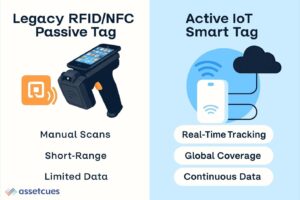
-
Legacy Methods – Barcodes, QR Codes, and RFID:
In the past, asset tagging meant barcodes or engraved IDs with manual scans. Barcodes and QR codes sped up inventory but still required line-of-sight and manual effort. The next leap, RFID tool tracking, enabled wireless, contactless scanning, while NFC asset tracking allowed simple tap-to-log actions using readers or smartphones.
However, passive RFID/NFC have short range, limited data storage, and no real-time tracking without costly infrastructure. As a result, older methods improved identification speed but lacked continuous visibility and intelligent analytics, leaving managers without a complete picture of asset status.
-
IoT Era – Active Smart Tags:
IoT-based tagging uses smart tags like Bluetooth beacons, GPS trackers, and cellular IoT devices with built-in power and connectivity. These tags transmit real-time location and sensor data over Wi-Fi, cellular, or IoT networks, enabling global asset tracking. Bluetooth asset tracking pinpoints indoor positions, while GPS IoT tags track worldwide. Centralized in the cloud, this data creates a live “digital twin,” shifting asset tracking from periodic snapshots to continuous, intelligent monitoring.
To illustrate the differences, here’s a quick comparison of RFID vs. IoT tagging systems:
| Feature | RFID Tool Tracking (legacy) | IoT Smart Tags (modern) |
| Range & Coverage | A few feet to yards (reader needed nearby) | Wide-area (Wi-Fi, cellular, GPS – even global) |
| Data & Sensors | ID only (just an identifier) | Rich data (precise location, temperature, motion, etc.) |
| Real-Time Updates | Requires periodic/manual scans | Continuous real-time streaming of data |
| Power Source | Passive (no battery) or short-range active (battery) | Battery/solar powered devices (long battery life) |
| Primary Uses | Inventory counts, tool check-in/out (localized) | Tracking assets across facilities, in-transit visibility, condition monitoring |
Table: Comparing traditional RFID tagging vs. IoT-based tagging. As shown above, IoT tags greatly extend the range and data capabilities beyond what older RFID or NFC tags offer.
-
Integration of Old & New
Legacy tagging remains useful, with modern IoT asset systems integrating RFID and NFC strategically. QR codes or NFC enable quick scans, RFID handles bulk reads, and IoT GPS trackers provide real-time tracking for valuable assets. This hybrid approach ensures full coverage while controlling cost and complexity.
-
Use Case – Evolution in Practice:
Previously, RFID tool tracking required manual scans, leaving records outdated between updates. Now, small IoT beacons automatically log movements, trigger alerts, and display real-time locations in an app. This transition from manual to smart tracking reduces search time, prevents losses, and significantly boosts efficiency—prompting many organizations to upgrade from RFID to IoT tagging.
Benefits and Use Cases of IoT and AI in Asset Management
Adopting IoT and AI for asset tracking delivers significant, tangible business benefits. Moreover, key use cases resonate with IT Asset Managers, Operations teams, and equipment managers. These examples demonstrate how IoT and AI address common asset challenges and why investing in them pays off.
-
Improved Asset Visibility & Utilization:
With IoT + AI, organizations maintain a live inventory of all assets in real time. Managers instantly see which assets are active, idle, or misplaced, enabling smarter utilization. For example, unused equipment can be redeployed instead of buying new. Gartner reports real-time tracking boosts asset utilization by about 18%, cutting costs and downtime.
-
Reduced Loss and Theft:
IoT tagging greatly reduces asset loss, misplacement, and theft by providing last-seen locations and movement alerts. Staff can quickly find misplaced items or act on unauthorized movement. Businesses using real-time tracking report a 30–50% drop in loss incidents. From hospitals securing equipment to construction firms protecting machinery, IoT tracking deters theft and prevents costly disappearances.
-
Predictive Maintenance & Less Downtime:
Combining IoT sensors with AI analytics shifts maintenance from reactive to proactive. IoT devices track health indicators, while AI predicts failures before they occur, reducing downtime. In one case, AssetCues used IoT sensors and AI to detect a failing motor bearing, enabling scheduled replacement and avoiding breakdown. This approach cut unexpected downtime by ~30% and supports studies showing predictive maintenance can halve downtime and cut costs by up to 40%.
-
Workflow Automation & Cost Savings:
IoT and AI automate asset management by enabling real-time counts, instant reconciliation, and automatic reorders. AI also flags “ghost assets” and cleans registers, preventing errors and losses. These efficiencies save labor, cut write-offs, and optimize capital—often paying for the system itself.
-
Safety and Compliance:
In regulated or safety-critical industries, IoT and AI add vital protection. Sensors monitor conditions and trigger shutdowns or alarms before hazards occur, while AI analyzes trends to detect risks early. These tools also manage compliance tasks like inspections and certifications, ensuring deadlines are never missed. The result is improved safety, regulatory compliance, and reduced liability.
Read more about AI and IoT-enabled asset tagging and tracking>>
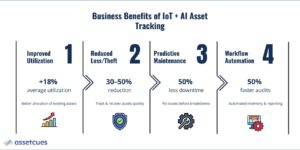
Expert Insight: “In our experience,” says AssetCues’s CTO, “integrating IoT and AI has halved audit times and boosted asset availability by 20%.” Moreover, this underscores the transformative impact of these technologies. By automating tracking and optimizing usage, IoT and AI enhance efficiencies, improve asset recovery, and enable smarter decision-making—delivering clear ROI.
Future of Asset Tagging: Trends on the Horizon
The convergence of IoT and AI is just the beginning. Looking ahead, several emerging trends promise to further revolutionize asset tagging and tracking in the coming years. Here are some key developments on the horizon:
-
Digital Twins for Assets:
Digital twins are virtual replicas of assets, updated in real time with IoT sensor data. Linking equipment to its twin lets managers test scenarios and predict outcomes risk-free. For example, AI simulations can forecast failures or show how schedule changes affect lifespan. With the market growing rapidly, digital twins are set to become essential for asset maintenance and planning.
-
5G and Enhanced Connectivity:
Next-gen networks like 5G and LPWAN will significantly enhance asset tracking capabilities. Moreover, faster speeds, higher bandwidth, and low latency enable real-time data from more devices anywhere. Additionally, ultra-wideband offers inch-level indoor accuracy, surpassing Bluetooth tracking in large facilities. With IoT devices projected to exceed 32 billion by 2030, robust connectivity becomes essential.
-
AI Becomes Prescriptive:
Today’s AI predicts failures, while prescriptive AI will recommend or trigger corrective actions. Future systems may schedule repairs, order parts, or optimize asset rotations autonomously. Managers will set rules, but AI will handle most routine planning tasks efficiently. This shift will reduce managerial burden and maximize asset utilization at the right time.
-
Integration with Other Emerging Tech:
Asset tracking is merging with blockchain, AR, and robotics to improve security and efficiency. Additionally, blockchain records tamper-proof asset histories for high-value or traceable items. AR glasses guide workers and display real-time status, while drones and robots handle remote inspections. Ultimately, these technologies enable a more automated, interactive, and secure asset management future.
-
Sustainability and ESG Goals:
Future asset tagging actively promotes sustainability by reducing waste and optimizing resource use. Additionally, IoT sensors monitor energy, detect idle machines, and significantly improve efficiency. Furthermore, companies leverage IoT and AI to cut carbon footprints and enable recycling. Ultimately, smarter asset management reduces overproduction, overstock, and energy waste, advancing critical ESG goals.
The future of asset tracking is becoming more integrated, intelligent, and interconnected. Analysts project the market to grow from $23 billion in 2024 to nearly $60 billion by 2032, driven by IoT and AI. Early adopters gain efficiency and data insights, while laggards face blind spots and higher costs. Adapting to these emerging technologies is essential to stay competitive.
FAQ
Q1. Can NFC be used for tracking?
A: Yes, NFC can effectively track assets through passive tags attached to equipment, tools, or inventory. NFC asset tracking uses smartphone scanning to instantly access location data, maintenance history, and asset details. However, NFC requires close proximity (typically 4 inches or less) and scans one asset at a time, making it ideal for secure, controlled tracking environments.
Q2. What is the difference between NFC and RFID?
A: RFID operates at longer ranges (up to 100 meters) and can scan multiple assets simultaneously, while NFC works only within a few centimeters and scans one tag at a time. RFID uses dedicated readers and infrastructure, whereas NFC tags work with standard smartphones. NFC offers two-way communication and higher security, while RFID excels at bulk inventory management and warehouse operations.
Q3. How can AI reduce asset downtime or losses?
A: AI reduces asset downtime by predicting issues before they cause failures. It analyzes trends in asset data, flagging warning signs like rising temperatures or unusual usage patterns. This enables proactive maintenance, preventing breakdowns—for example, alerting when a generator may overheat soon. AI also detects anomalies in movement or location, alerting managers to theft or misplacement, minimizing both downtime and losses.
Q4. What is an equipment tagging system?
A: An equipment tagging system combines hardware and software to label and track assets. Traditionally, organizations used barcodes or RFID tags with scanners to record asset movements. However, modern solutions employ IoT tags or sensors that send data to cloud platforms, enabling real-time tracking of location, usage, and condition. Ultimately, these systems integrate tags, network infrastructure, and software to ensure accurate, up-to-date inventory throughout the asset lifecycle.
Conclusion and Call to Action
-
Summary:
IoT and AI are transforming asset tracking into efficient, practical solutions. Additionally, IoT tags and AI analytics provide real-time visibility and automate tasks. From finding tools with Bluetooth beacons to predicting maintenance, efficiency improves. Ultimately, these technologies reduce losses, minimize downtime, and boost productivity.
-
Next Steps – Get Started with IoT Tracking:
Ready to modernize your asset tracking? Move beyond spreadsheets and basic RFID to connected, intelligent tagging. AssetCues combines IoT sensors with AI analytics for real-time tracking, alerts, and predictive insights. Our platform delivers live asset maps, maintenance forecasts, and smarter operational decisions. Schedule a demo today to future-proof your asset management and gain a competitive edge with IoT-enabled solutions.




